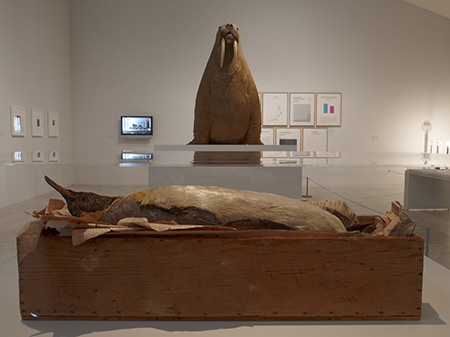Curiosity

The day I visited ‘Curiosity’, curated by Brian Dillon, was, coincidentally, the 101st birthday of that continually curious provocateur John Cage. On the train thereI read a decaying, secondhand copy ofJorge Luis Borges’s Labyrinths (1962), a compendium of meticulously expressed illogicalities. ‘The Library of Babel’, especially, is a furious thicket of underlining and marginalia … curious, no? Walking through the 12 rooms of ‘Curiosity’ is a little like inhabiting an institution from one of Borges’s tales. It involves an immensely pleasurable accumulation of detail, bizarre objects, obscura, things peculiar and perverse, accounts of magical thinking, illustrations of obsession, quixotic undertakings in the name of certain lost fields of knowledge, fanciful peregrinations acrossthe wilder, more whimsical terrain of the mind, all caused by this ticklish desire to know more.
This is a deliciously promiscuous show, dedicated to a frisky commingling of thehistorical and vividly contemporary. The whole landscape is too variegated to be neatly described, which is part of its pleasure, a particular sprawling, cerebral excessiveness that means any account is doomed (maybe desirably so?) to be a tantalizing fragment. Dillon is a writer of rare sharpness and lucidity – and, more quietly, a spirited intellectual mischief – whose criticism revels in precisely this kind of energetic restlessness. Objects of his attention for this very magazine have included, among other things: ruins, slapstick, Susan Sontag and the history of the essay. He is also the UK editor of Cabinet, the quarterly distinguished by its studious commitment to neglected areas of aestheticsand Wunderkammer-ish editorial approach – learned disquisitions on dust and balloons have graced its pages. The same spirit of excitement and erudition and marks ‘Curiosity’, which basks in the abundance of meanings that this nimble word accommodates.
Curiosity can include a fascination with the superficially banal or ‘infra-ordinary’, that aesthetic category defined by Georges Perec, which values ‘questions about things that have ceased forever to astonish us’. Elad Lassry’s eerily vacant, oddly lurid photographs of a blonde teen, a nocturnal landscape and a cat are the sort of thing you might see in a dentist’s waiting room – the infra-ordinary par excellence. Gerard Byrne’s ludic environmental studies, which revealthe spooky vulnerability of twigs, fall into the same category. A few steps away arethe occult implements of Dr. John Dee, the Elizabethan polymath, then a gorgeous assortment of opalescent stones collectedby the Surrealist-anthropologist Roger Caillois, followed by a set of unnerving portraits of scowling and sorrowful birds by J.M.W. Turner, who painted Margate and its coastal environs from childhood until his death.
Miroslav Tichý’s haunting snapshots of girls in various Czech parks are here, too,symptoms of a Blue Velvet-ish kind of curiosity,though they’re maybe most peculiar intheir technical provenance, as they were caught on a homemade camera builtfrom cardboard and salvaged glass. Dating from between 1950 and 1980, they recall 19th-century spiritualist photographs, their subjects resemble wraiths peering outof a toxic mist. Tichý was possibly the first person to detect the erotic properties of shadows.
Nina Canell’s The New Mineral (2009) might be a newly discovered readymadeby Marcel Duchamp: a reconstructionof an early radiometer built by the Victorian occultist William Crooks, it consists of dimly glowing light-bulbs on broomsticks, all but one containing dreamily twirling spindles. Oddly exemplary of much of the exhibition, this piece occupies some seductive, mysterious territory between weird science experiment and darkly metaphorical, uncanny invention.
The version of contemporary art that ‘Curiosity’ suggests is one which takesa sly joy in playing with science like a Surrealist playing with a journalist, feeding it metaphysical riddles it can’t comprehend: see, for instance, Toril Johannessen’simpossible graphs, transformations of data into exquisitely meaningless abstractions that purport to record ‘Love and Logic inArt’ or ‘Miracles in Nature and Science’ (2011). Elsewhere, there’s a section of Agency’s sombre archive project Curiosity (Assembly) (1992–ongoing). Row upon row of boxes are neatly serried to the ceiling, their contents indexed but history obscure; a typical box contains a telephone directory, a copy of Jean Genet’s The Thief’s Journal (1949) and ‘The Magician’s Coat Sequence’. The thought of all these quietly ageing things is inescapably tragic. It’s an oblique reminder that Dillon is a nonpareil writer on memory and melancholy. Two Tacita Dean filmspossess a similar tinge of sadness: Manhattan Mouse Museum (2011) observes a wizened Claes Oldenburg feeling through shelf aftershelf of tchotckes in his studio; Prisoner Pair (2008) records the luscious decay of pearsin glasses of schnapps. Dean’s sort of curiosity unspools slowly and involves the enraptured contemplation of quiet things.
Marooned on a plinth in another gallery,the Horniman Walrus makes its own comic call for attention. A gargantuan, loveable beastshot in the Hudson Bay in the 1880s, it was overstuffed by taxidermists so the characteristic folds in its skin disappeared. It looks smooth as a stone, then on more careful inspection,as if upholstered in moth-eaten velvet. (What, precisely, is inside this animal?) Delightful histories like this abound, glittering with novelistic detail. Close by the walrus lies a stuffed penguin in a wooden box, retrieved from oneof Ernest Shackleton’s expeditions. A few of his letters surround the bird, written with inscrutably fine penmanship. The box is lined with rusty newspaper and inevitably recalls a coffin, soI think of this penguin as a little tyrant lying in state. Near the belly, I spot an article lamentingthe death of ‘a nineteen year old cow’, nextto something about ‘a beautiful stocking’, a juxtaposition that feels strangely reflectiveof the arrangement of the exhibition.
There are many other astonishing things here (astonishment of various kinds is theexhibition’s intention): Rolodexes of decomposing business cards, more disconcertinganimals, photographs of sinister clergymen stargazing … Such profusion is thrilling, disorientating and rare. Borges would applaud its fleeting appearance in the world.














